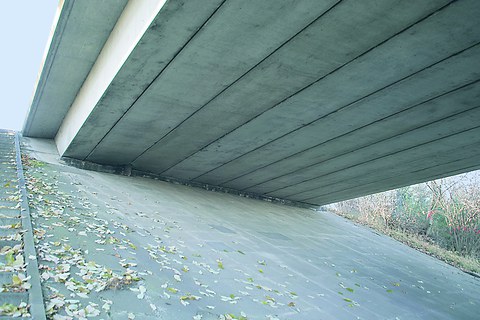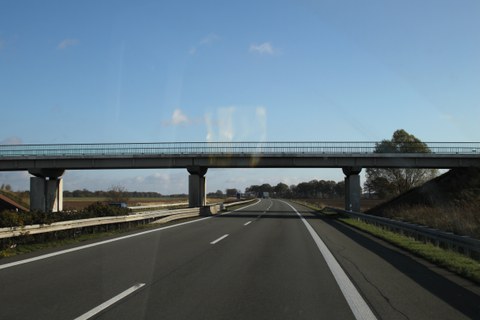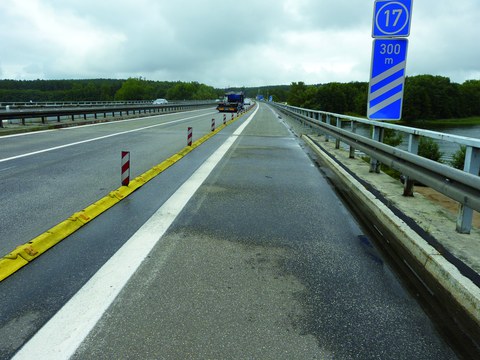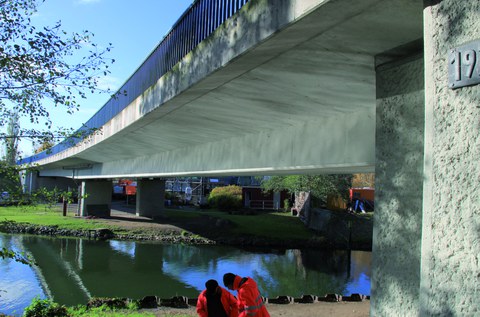Scientific and technical supervision for application of the German recalculation guideline on the bridge stock of Mecklenburg-West Pomerania
Table of contents
Project data
| Titel | Title Wissenschaftlich-technische Betreuung (WTB) beim Projekt zur Anwendung der Nachrechnungsrichtlinie auf den Brückenbestand Mecklenburg-Vorpommerns | Scientific and technical supervision for application of the German recalculation guideline on the bridge stock of Mecklenburg-West Pomerania Auftraggeber | Funding Landesamt für Straßenbau und Verkehr Mecklenburg-Vorpommern Zeitraum | Period 05/2011 − 06/2016 Leiter | Project manager Dr.-Ing. Torsten Hampel Bearbeiter | Contributor Dipl.-Ing. Nico Schmidt, Dipl.-Ing. Oliver Steinbock, M.Sc. Mateusz Ewertowski |
Report in the year book 2016
Existing road bridges – symbiosis between research and practice

Bottom view of a 4-span superstructure compounded of cellular concrete boxes with shear keys over BAB A14 between Wendischbora and Nossen
Since the introduction of the ‘Nachrechnungsrichtlinie’ (German recalculation guideline, in short: NRR) in 2011, the assessment of existing road bridges has become increasingly the focus of research. When looking at older structures, a differentiated approach is necessary, because the old bridges have been designed and built according to former standards. There are two main reasons for that: on the one hand, in the past, we have dealt with lower traffic loads and requirements than the ones we have today. On the other hand, today we know more about the mechanical behavior of our materials and the load-bearing mechanisms of the bridge superstructures. Now, there are extensive sets of rules which allow us to design in a complex way while minimizing the risk of errors and including the latest research results.
The German recalculation guideline was added by a first supplement in 2016. In particular, the chapter about concrete bridges was revised and upgraded by a special working group of the BASt (Federal Highway Research Institute) by different research projects. One reason was that recalculations had shown, that in most cases, it is not possible to fulfill all requirements of the verification of the shear load bearing capacity of older concrete bridges according to currently valid standards. With the introduction of this first supplement, it is now allowed to calculate the load bearing capacity of a bridge on the basis of the main tensile stresses. In many cases, the load-bearing capacity can be confirmed at level 2 of the NRR without further restrictions.
Within the framework of our research project, on behalf of the Traffic and Transportation State Office of Mecklenburg-Western Pomerania, we used the criterion of the main tensile stresses successfully when looking at prefabricated bridge structures built during the former GDR. It was also possible to use alternative calculation methods according to level 4 of the guideline, but here we needed an agreement of the supreme building authority.
Within the project, we worked with bridge superstructures made of different materials. We have collected a lot of information about the different construction types which were built in the former GDR. For instance, there are some special characteristics by steel bridge decks or in the calculation of arch structures. These findings should be implemented in further supplements of the guideline.
Report in the year book 2015
Safe road bridges

Cross section of a typical prestressed concrete superstructure for detailed studies of load-bearing behavior, especially for torsion
With the introduction of the new recalculation guideline in Germany, a large number of road bridges shall be evaluated accordingly, as it has been done within this research project for bridges in Mecklenburg-West Pomerania. In some cases, the capacity of the structures considered were found to be insufficient, even using the supplementary regulations at level 2 of the guideline. This applies mainly to the calculated shear strength capacity of prestressed concrete superstructures, but also to steel superstructures that are deficient e.g. in terms of their safety against buckling, which do not meet current requirements. Therefore, scientific methods were applied to solve these problems, according to recommendations at level 4 of the guideline.
As an example, the shear strength of a prestressed concrete superstructure was verified section by section using a conventional strut-and-tie model in combination with an arch-tension chord model. By that, the traditional separation of the designs for bending and for shear is overcome and a more accurate interaction of the design shear forces and bending moments is considered instead. In doing so, yet unexploited reserve load capacities can be accounted for, and the design capacity can be increased for structural verification without restrictions for traffic.
As a second example, it was found that the main load carrying members of a large steel bridge did not comply with the actual safety requirements for buckling. The underlying facts were investigated. Within this context, the current design rules were compared with the original ones and the assumptions for recalculation were critically questioned. With a slightly reduced live load level, the calculated design capacity eventually was found to be sufficient for this structure. As a result of the structural recalculation, extensive traffic restrictions are necessary until the retrofitting of the critical areas is completed.
Precast beam series are a type of structure that is widely used in the bridge inventory. Their load bearing behaviour were analysed in depth using refined structural models. Conventional calculation methods based on beam grillage models were used as well as shell structures and folded shell structures. The results of the investigations were compared in terms of sectional forces and moments. Based on that, solutions should be found to overcome deficiencies, in particular for the design torsional capacity of the precast beam elements.
Report in the year book 2014
Road bridges at the limit

Typical precast beam bridge in Mecklenburg-West Pomerania
In this project, the bridge inventory of Mecklenburg-West Pomerania is investigated. A representative sample of thirty different structures has been selected for the study.
For many of the prestressed concrete superstructures, the shear design capacity is not sufficient, even taking into consideration additional provisions according to the new German recalculation guideline (Nachrechnungsrichtlinie NRR, status of 05/2011). Therefore, scientific methods, based on the latest research, have been applied (level 4, NRR) in anticipation of future amendments to the guideline. For one of the prestressed concrete superstructures, additional scientific investigations are necessary.
For typical precast beam structures, when modelling the joints, additional considerations are necessary; otherwise, shear and torsion capacity deficits occur. Most critical are large spans with skew shape in plan, as well as beams that lack sufficient bond to the top slab. Design approaches are currently being developed to analyse such cases.
Reinforced concrete structures built in the 1960’s are critical because of the low grade reinforcement used. Current material test results deliver explicit data of the existing material properties, including the reinforcement. Certain sections of these concrete structures lack reinforcement at all, or the reinforcement provided is not sufficient. Those ancient design principles are critically assessed and compared to current design criteria.
Further classification of a composite steel and concrete bridge superstructure overpassing federal route A 19 will be based on current measurements (level 3, NRR). The investigations in the course of a student’s diploma thesis showed, however, a series of influence factors of unknown magnitude that require additional considerations to be continued in cooperation with the authority. Further use of this bridge structure will be decided upon the authority’s final decision.
Finally, based on the findings of the study for each specific bridge type, the requirements for further bridge inspections are being customized considering the needs of the authority.
Report in the year book 2013
Road Bridges Through a Lens

Traffic compensation measure for an existing bridge
The application of design rules for new bridges to existing ones undoubtedly causes problems that will require deeper investigations. Therefore, special regulations for the recalculation of existing bridges, which have recently been introduced by the Federal Government are necessary. In this project we investigate the stock of road bridges in Mecklenburg-West Pomerania based on the so called “Nachrechnungsrichtlinie”.
Experiences with this project so far confirm the importance of a complete documentation of structures as a key element for the assessment of existing bridges beyond pure recalculation. Besides structural safety and durability the road safety also lies in the focus of the motorists. The higher demands are reflected by the increased design level which cannot be simply transferred to the majority of the existing bridge structures investigated so far. Therefore we contribute to attempts to develop solutions.
Apart from a structural recalculation, an examination of the basic structure of a bridge is necessary to assess an existing structure. In this context, aspects of system modelling are at least of equal importance to the consideration of material testing results. Detail design checks provide information about structural deficits and reserves. Comparing analysis results with the actual condition of the existing bridge structure allows a realistic evaluation of calculative deficits and thus enables the authority to better evaluate the scope for their further use. For certain bridges the calculative live loads were obtained from preliminary investigations as an essential input parameter for the structural recalculations.
In single cases we participated directly in the bridge examinations of critical structures to analyse their most crucial parts individually. It was repeatedly necessary to apply alternative design approaches based on scientific methods and to evaluate the results on the basis of the German code. Types of construction which may be typical for a particular region require the adaptation of standardized structural design checks for their application in the particular case. The effort for recalculation is reduced by the help of limit value considerations.
Report in the year book 2012
Road Bridges Re-Evaluated

On-site inspection of a recalculated bridge
One cannot imagine infrastructure without bridges. Existing bridges have to be reassessed in accordance with the current state of the art due to the increasing traffic volume and the steadily growing traffic loads. For the project introduced here we are responsible for the scientific and technical supervision for the reassessment of roadway bridges in the northeastern German federal state Mecklenburg-West Pomerania on the basis of the new German recalculation guideline of the Federal Government.
After analysis, the total stock of road bridges was split up into single groups mainly according to the main building material and to the type of superstructure. For each group one or two bridges were chosen as representatives and were recommended for recalculation to the authority. Additionally certain bridge structures were chosen directly by the Federal Government and the federal state for recalculation.
The structural recalculations themselves were prepared by consulting engineers. In addition to the pure structural analyses this included an inspection of the bridge on-site to assess the actual condition of the structure and to consider it for the recalculation if necessary. The so prepared calculations were then checked at our institute regarding completeness and correctness. We furthermore advice the consulting engineers and we give appropriate guidance at crucial parts of the structure and we investigate alternative solutions or approaches and discuss them together with the client.
In one individual case the recalculation of a prestressed hollow core bridge deck, built in 1970, yielded for example considerable deficits in shear design which is, however, not untypical for concrete structures which were built in that period of time. Since the allowable limits were exceeded not inconsiderably, immediate measures – in this case traffic restrictions – were recommended in coordination with the parties involved and implemented right from the beginning of 2013. The superstructure had been inspected on-site and subsequently a concept for material testing had been developed to provide specific material properties for a repeated recalculation.
Finally the whole stock of existing road bridges in the federal state Mecklenburg-West Pomerania will be reassessed by means of exemplarily investigations for each group. On that basis at the end of this project the operator may derive strategies for future investments.
